Studies on Oxygen Permeation Resistance of SiCN Thin Film and RRAM Applications
Abstract
1. Introduction
2. Materials and Methods
3. Results and Discussion
3.1. SiCN Film Properties with 4MS Partial Pressure Ratio
3.2. SiCN Film Properties after a Highly Accelerated Temperature and Humidity Stress Test
3.3. RRAM with SiCN as an Oxygen Reservoir
4. Conclusions
Author Contributions
Funding
Institutional Review Board Statement
Informed Consent Statement
Data Availability Statement
Conflicts of Interest
References
- Chiang, C.-C.; Chen, M.-C.; Wu, Z.-C.; Li, L.-J.; Jang, S.-M.; Yu, C.-H.; Liang, M.-S. TDDB Reliability Improvement of Cu Damascene with a Bilayer-Structured a-SiC:H Dielectric Barrier. J. Electrochem. Soc. 2004, 151, G89–G92. [Google Scholar] [CrossRef]
- Liu, B.; Yang, J.; Jiao, G.; Xu, K. Improvement of Interfacial Adhesion Strength and Thermal Stability of Cu/p-SiC:H/SiOC:H Film Stack by Plasma Treatment on the Surface of Cu Film. Plasma Sci. Technol. 2012, 14, 619–623. [Google Scholar] [CrossRef]
- Das, A.; Chattopadhyay, S.; Dalapati, G.K. Impact of oxygen diffusion on the performance of HfO2/GaAs metal-oxide-semiconductor field-effect-transistors. Adv. Mater. Lett. 2016, 7, 123–129. [Google Scholar] [CrossRef]
- Meyer, J.; Gorrn, P.; Bertram, F.; Hamwi, S.; Winkler, T.; Johannes, H.-H.; Weimann, T.; Hinze, P.; Riedl, T.; Kowalsky, W. Al2O3/ZrO2 Nanolaminates as Ultrahigh Gas-Diffusion Barriers—A Strategy for Reliable Encapsulation of Organic Electronics. Adv. Mater. 2009, 21, 1845–1849. [Google Scholar] [CrossRef]
- Park, J.; Woo, J.; Prakash, A.; Lee, S.; Lim, S.; Hwang, H. Improved reset break-down strength in a HfOx-based resistive memory by introducing RuOx oxygen diffusion barrier. AIP Adv. 2016, 6, 055114. [Google Scholar] [CrossRef]
- Gunn, J.E.; Malik, S.K.; Mazumdar, P.M. Highly Accelerated Temperature and Humidity Stress Test Technique (HAST). In Proceedings of the 19th International Reliability Physics Symposium, Orlando, FL, USA, 7–9 April 1981; pp. 48–51. [Google Scholar] [CrossRef]
- Zhao, Z.; Xia, K.; Hou, Y.; Zhang, Q.; Ye, Z.; Lu, J. Designing flexible, smart and self-sustainable supercapacitors for portable/wearable electronics: From conductive polymers. Chem. Soc. Rev. 2021, 50, 12702–12743. [Google Scholar] [CrossRef]
- Lv, Z.; Xing, X.; Huang, S.; Wang, Y.; Chen, Z.; Gong, Y.; Zhou, Y.; Han, S.-T. Self-assembling crystalline peptide microrod for neuromorphic function implementation. Matter 2021, 4, 1702–1719. [Google Scholar] [CrossRef]
- Adam, G.C.; Khiat, A.; Prodromakis, T. Challenges hindering memristive neuromorphic hardware from going mainstream. Nat. Commun. 2018, 9, 1–4. [Google Scholar] [CrossRef]
- Li, H.; Huang, P.; Gao, B.; Liu, X.; Kang, J.; Wong, H.-S.P. Device and Circuit Interaction Analysis of Stochastic Behaviors in Cross-Point RRAM Arrays. IEEE Trans. Electron. Devices 2017, 64, 4928–4936. [Google Scholar] [CrossRef]
- Wong, H.-S.P.; Lee, H.Y.; Yu, S.; Chen, Y.-S.; Wu, Y.; Chen, P.-S.; Lee, B.; Chen, F.T.; Tsai, M.-J. Metal–Oxide RRAM. Proc. IEEE 2012, 100, 1951–1970. [Google Scholar] [CrossRef]
- Lu, B.; Lu, Y.; Zhu, H.; Zhang, J.; Yue, S.; Li, S.; Zhuge, F.; Ye, Z.; Lu, J. Memristors based on amorphous ZnSnO films. Mater. Lett. 2019, 249, 169–172. [Google Scholar] [CrossRef]
- Wang, Z.; Wu, H.; Burr, G.W.; Hwang, C.S.; Wang, K.L.; Xia, Q.; Yang, J.J. Resistive switching materials for information processing. Nat. Rev. Mater. 2020, 5, 173–195. [Google Scholar] [CrossRef]
- Lv, Z.; Wang, Y.; Chen, J.; Wang, J.; Zhou, Y.; Han, S.-T. Semiconductor Quantum Dots for Mem-ories and Neuromorphic Computing Systems. Chem. Rev. 2020, 120, 3941–4006. [Google Scholar] [CrossRef]
- Kumar, D.; Aluguri, R.; Chand, U.; Tseng, T.-Y. Conductive bridge random access memory characteristics of SiCN based transparent device due to indium diffusion. Nanotechnology 2018, 29, 125202. [Google Scholar] [CrossRef]
- Chapelon, L.L.; Petitprez, E.; Brun, P.; Farcy, A.; Torres, J. Evaluation of a PECVD advanced barrier (k = 3.7) for 32 nm CMOS technology and below. Microelectron. Eng. 2007, 84, 2624–2628. [Google Scholar] [CrossRef]
- Jung, C.; Song, S.; Park, H.; Kim, Y.; Lee, E.J.; Lee, S.G.; Jeon, H. Characteristics of carbon-containing low-k dielectric SiCN thin films deposited via remote plasma atomic layer deposition. J. Vac. Sci. Technol. A Vac. Surf. Film. 2021, 39, 042404. [Google Scholar] [CrossRef]
- Ivashchenko, V.I.; Kozak, A.O.; Porada, O.K.; Ivashchenko, L.A.; Sinelnichenko, O.K.; Lytvyn, O.S.; Tomila, T.V.; Malakhov, V.J. Characterization of SiCN thin films: Experimental and theoretical investigations. Thin Solid Film. 2014, 569, 57–63. [Google Scholar] [CrossRef]
- Yamamoto, K.; Koga, Y.; Fujiwara, S. XPS studies of amorphous SiCN thin films prepared by nitrogen ion-assisted pulsed-laser deposition of SiC target. Diam. Relat. Mater. 2001, 10, 1921–1926. [Google Scholar] [CrossRef]
- Mallorquí, A.D.; Llado, E.A.; Mundet, I.C.; Kiani, A.; Demaurex, B.; De Wolf, S.; Menzel, A.; Zacharias, M.I.; Morral, A.F. Field-effect passivation on silicon nanowire solar cells. Nano Res. 2014, 8, 673–681. [Google Scholar] [CrossRef]
- Klein, T.M.; Anderson, T.M.; Chowdhury, A.I.; Parsons, G.N. Hydrogenated silicon nitride thin films deposited between 50 and 250 °C using nitrogen/silane mixtures with helium dilution. J. Vac. Sci. Technol. A 1999, 17, 108–112. [Google Scholar] [CrossRef]
- Chen, Z.; Lin, H.; Zhou, J.Y.; Ma, Z.; Xie, E. IR studies of SiCN films deposited by RF sputtering method. J. Alloy. Compd. 2009, 487, 531–536. [Google Scholar] [CrossRef]
- Simanjuntak, F.M.; Panda, D.; Wei, K.-H.; Tseng, T.-Y. Status and Prospects of ZnO-Based Resistive Switching Memory Devices, Nanoscale Res. Lett. 2016, 11, 368. [Google Scholar]
- Isyaku, U.B.; Khir, M.H.B.M.; Nawi, I.M.; Zakariya, M.A.; Zahoor, F. ZnO Based Resistive Random Access Memory Device: A Prospective Multifunctional Next-Generation Memory. IEEE Access 2021, 9, 105012–105047. [Google Scholar] [CrossRef]
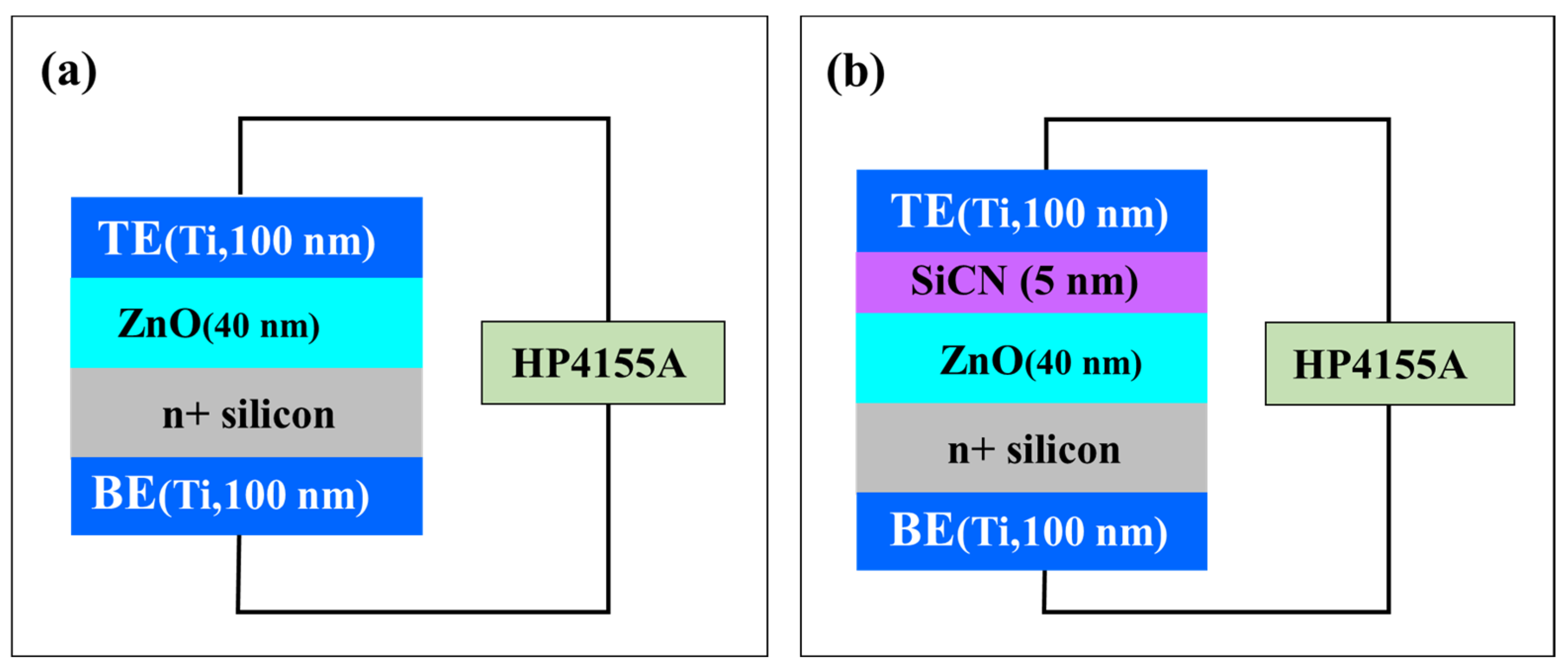
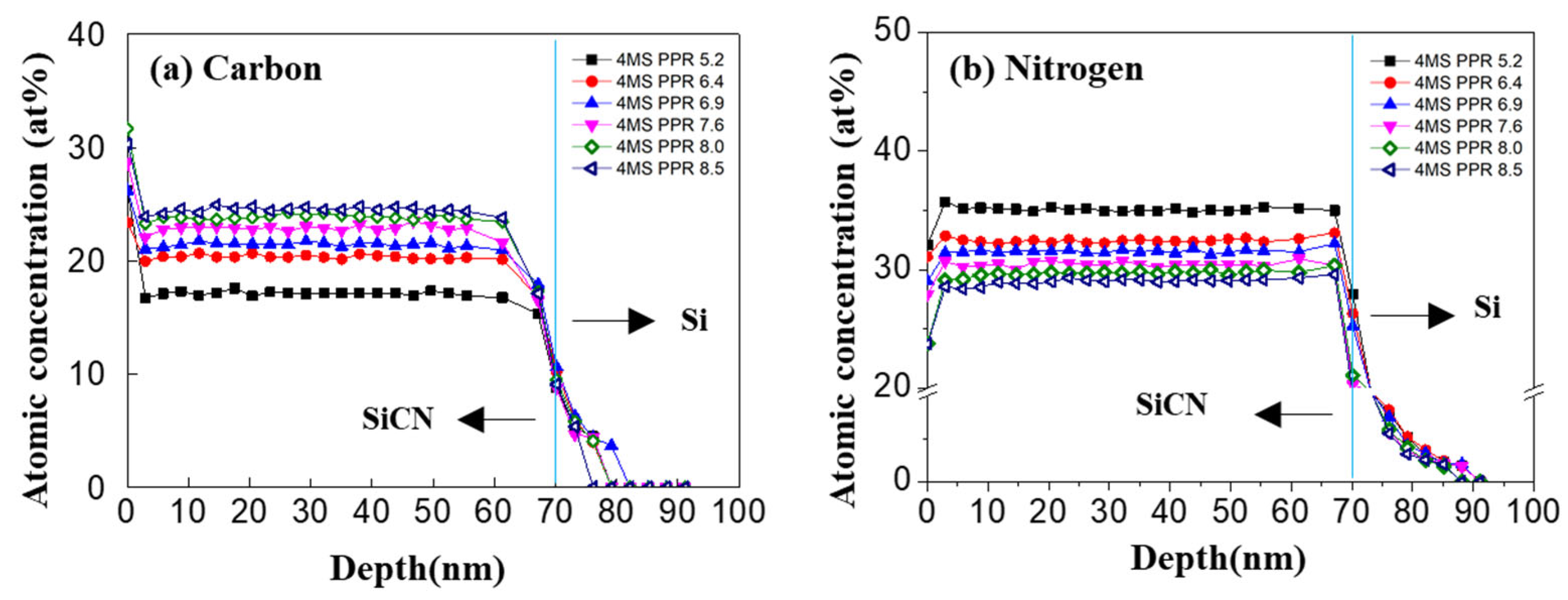
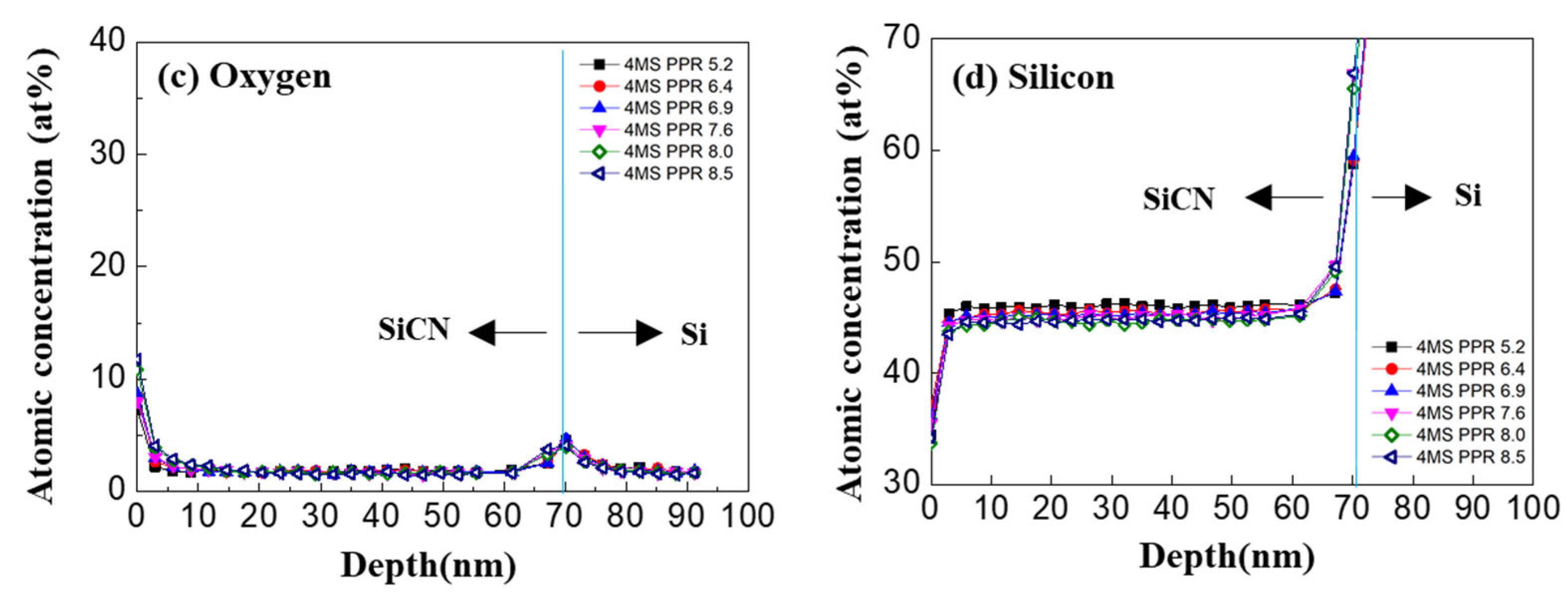
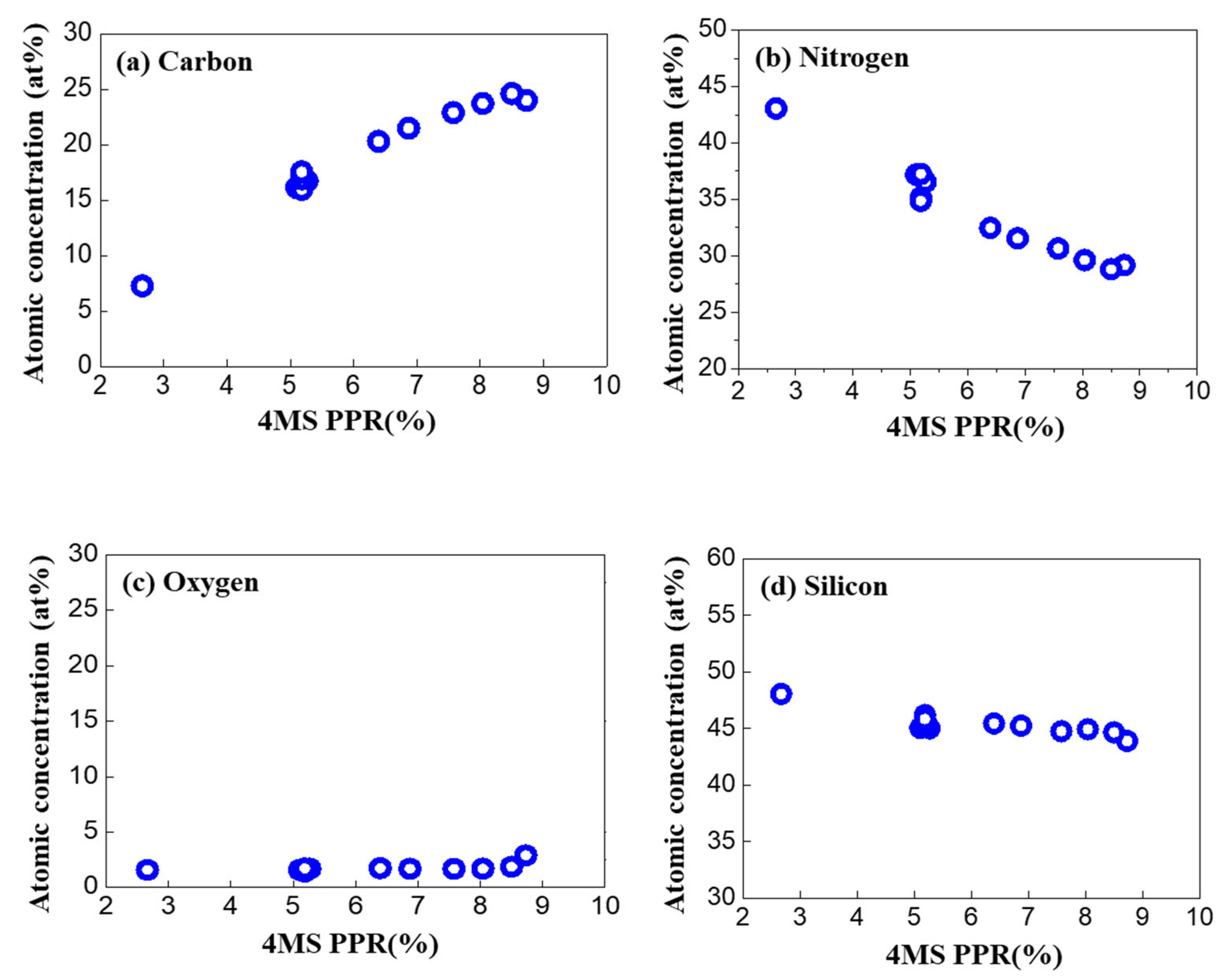
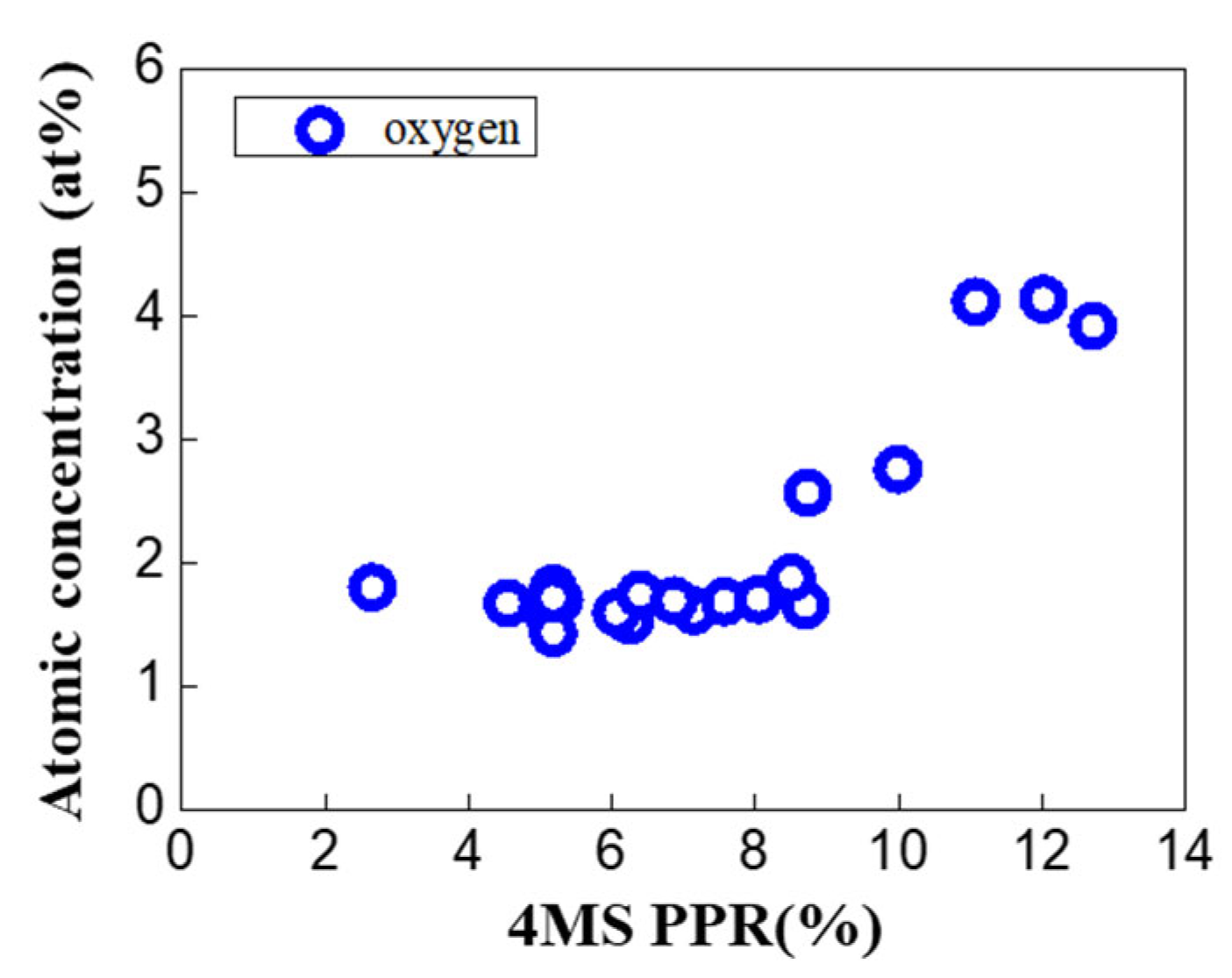
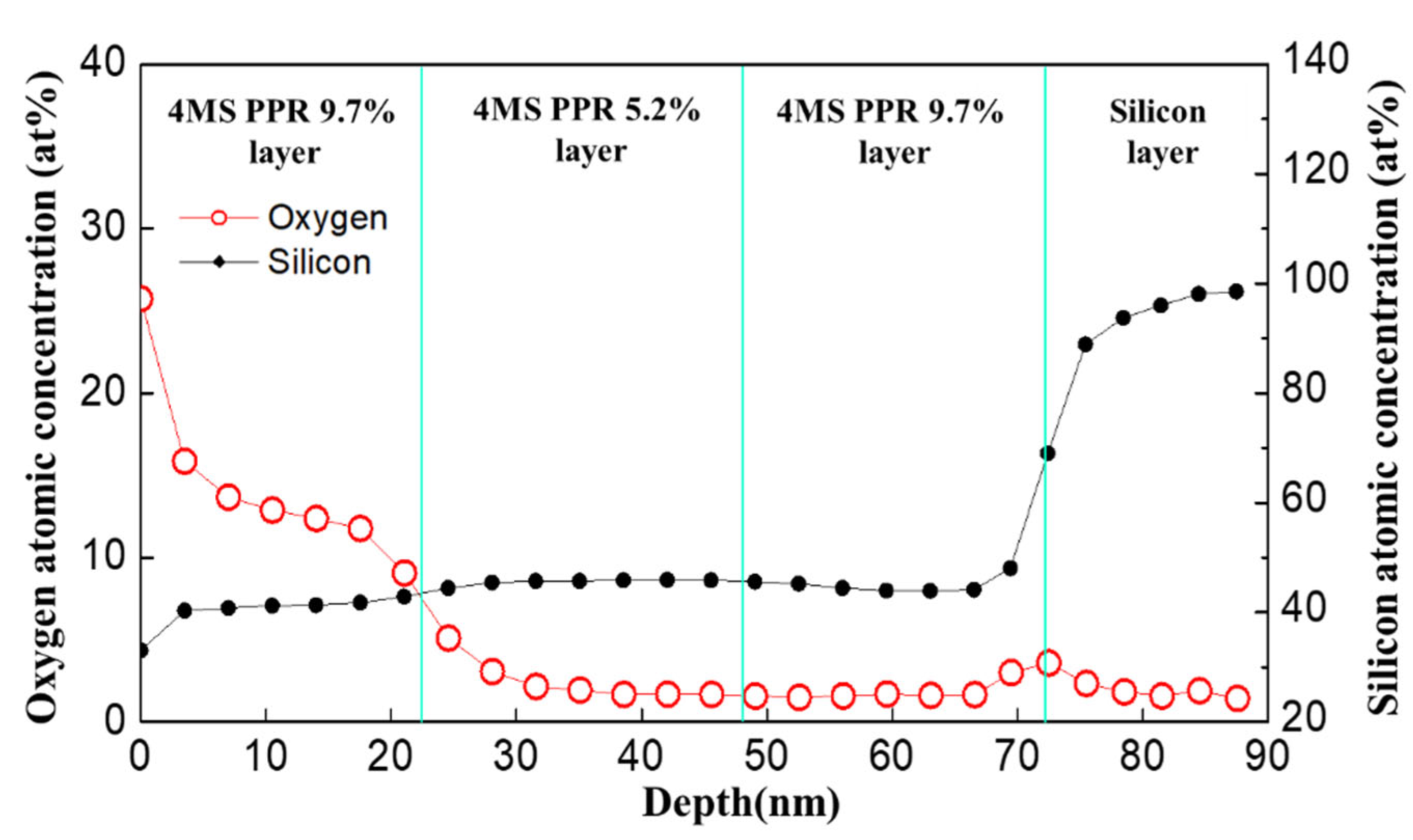
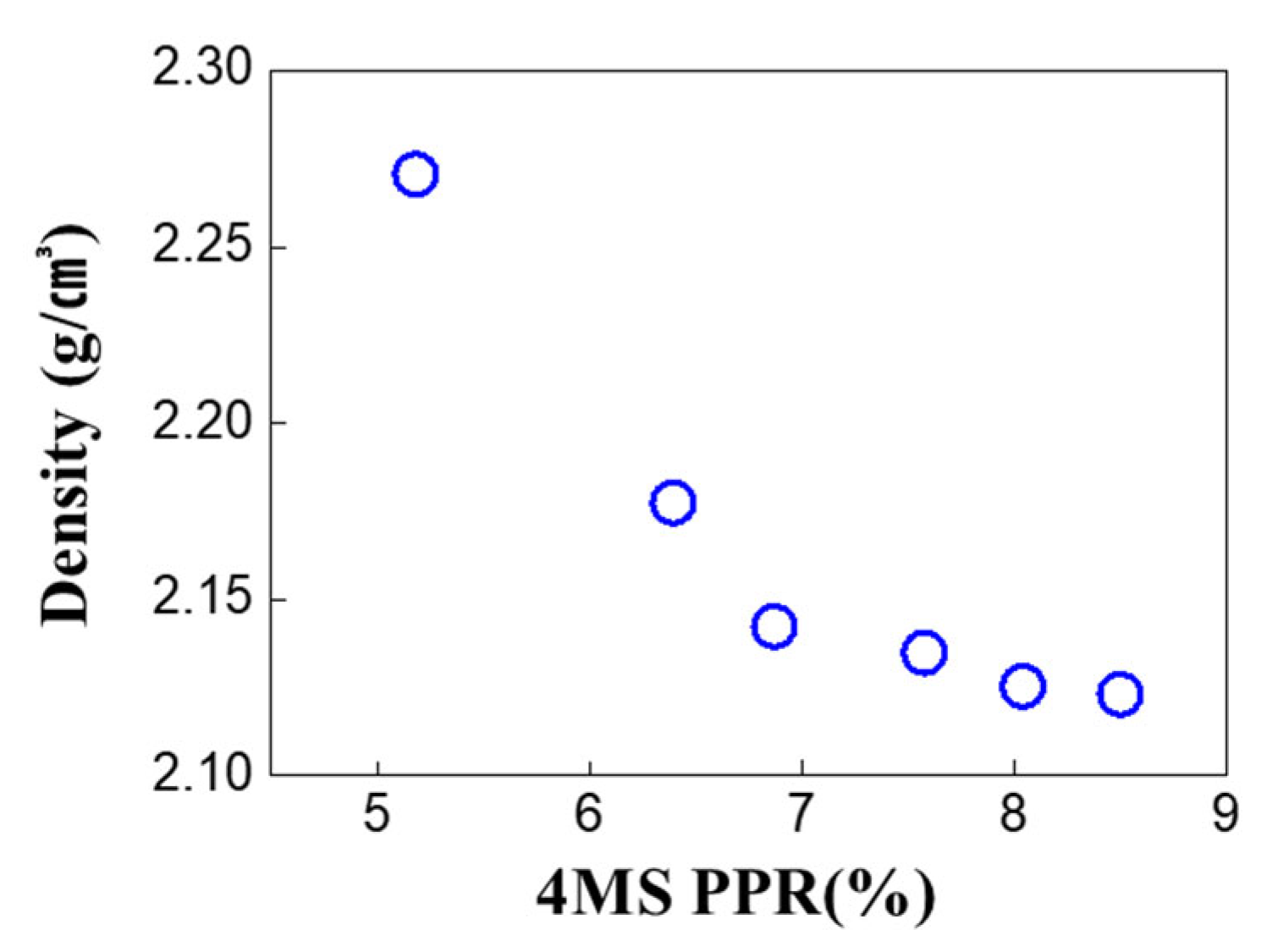
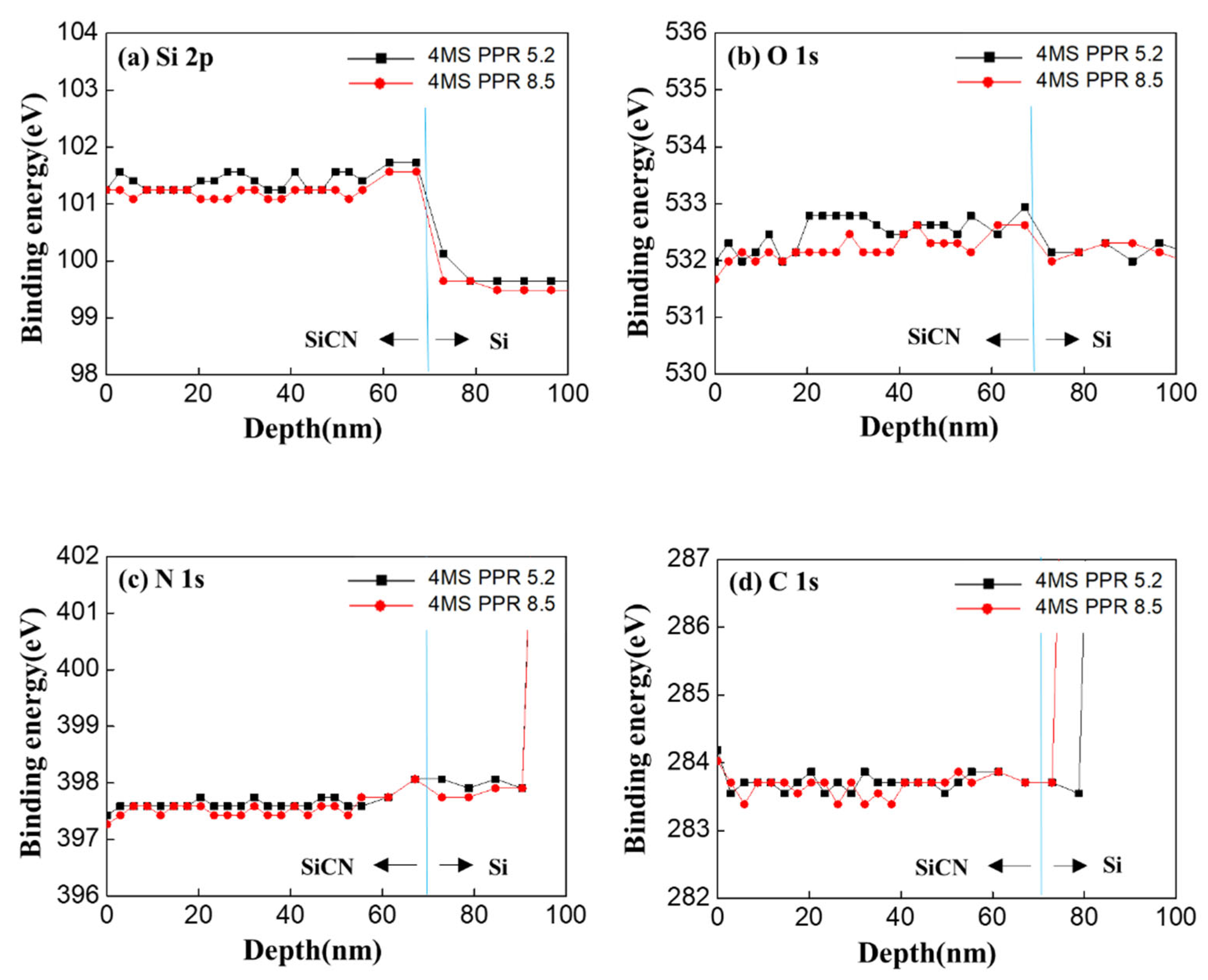
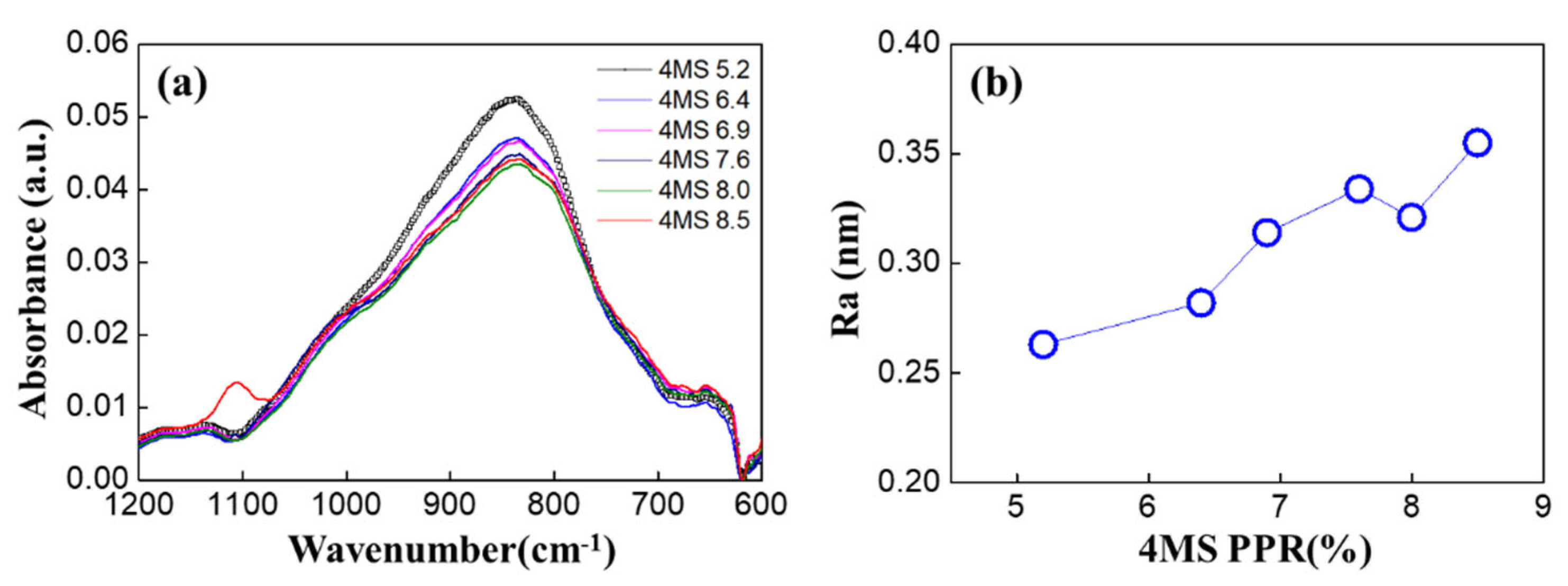
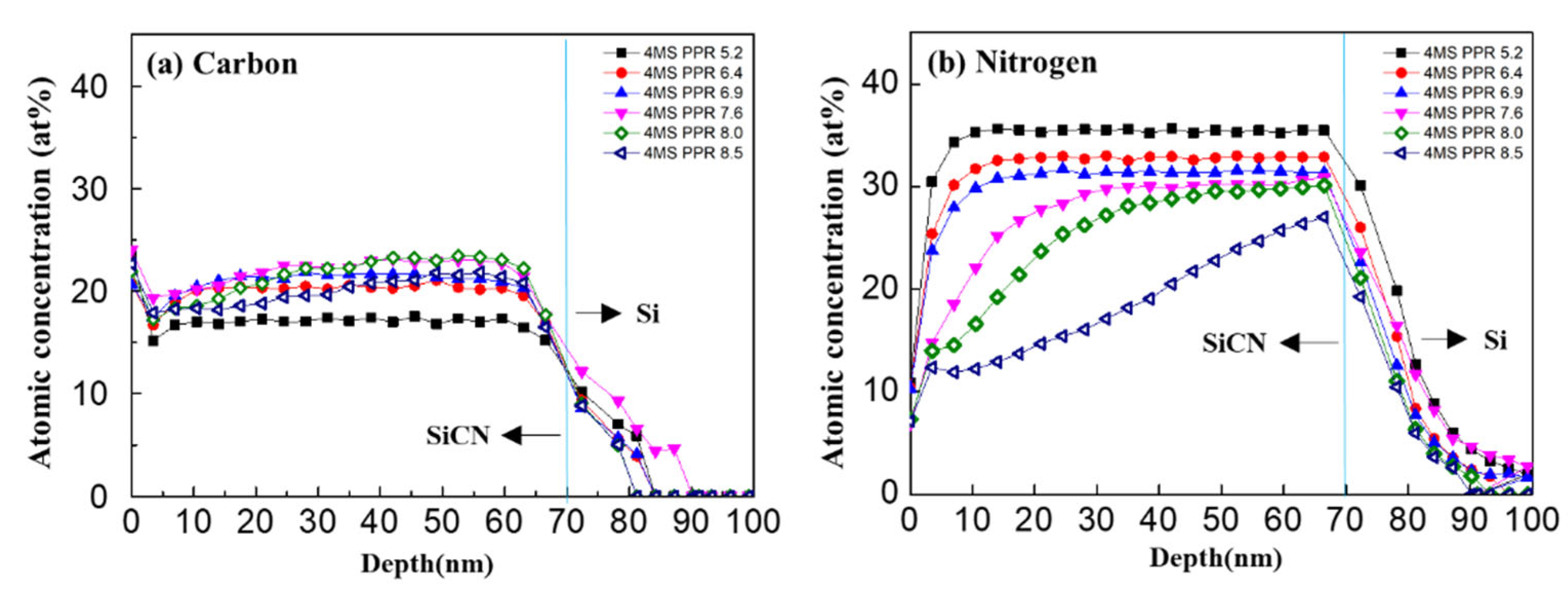
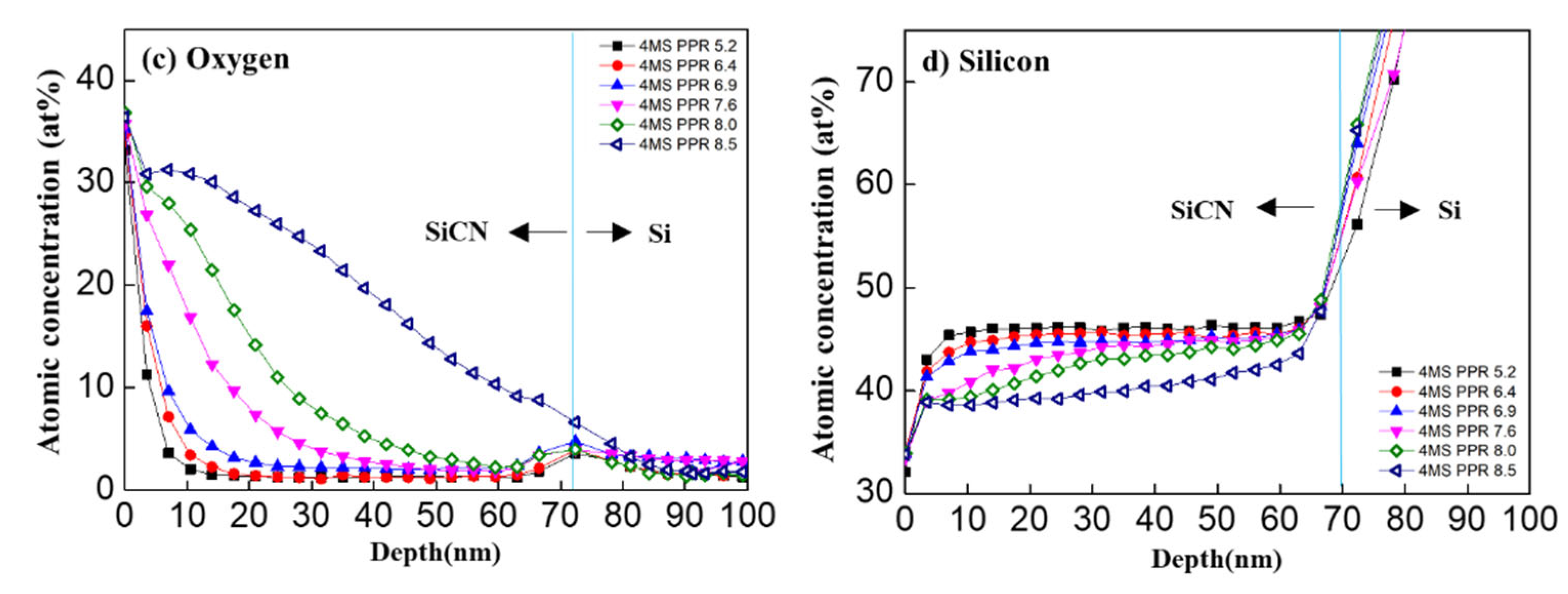
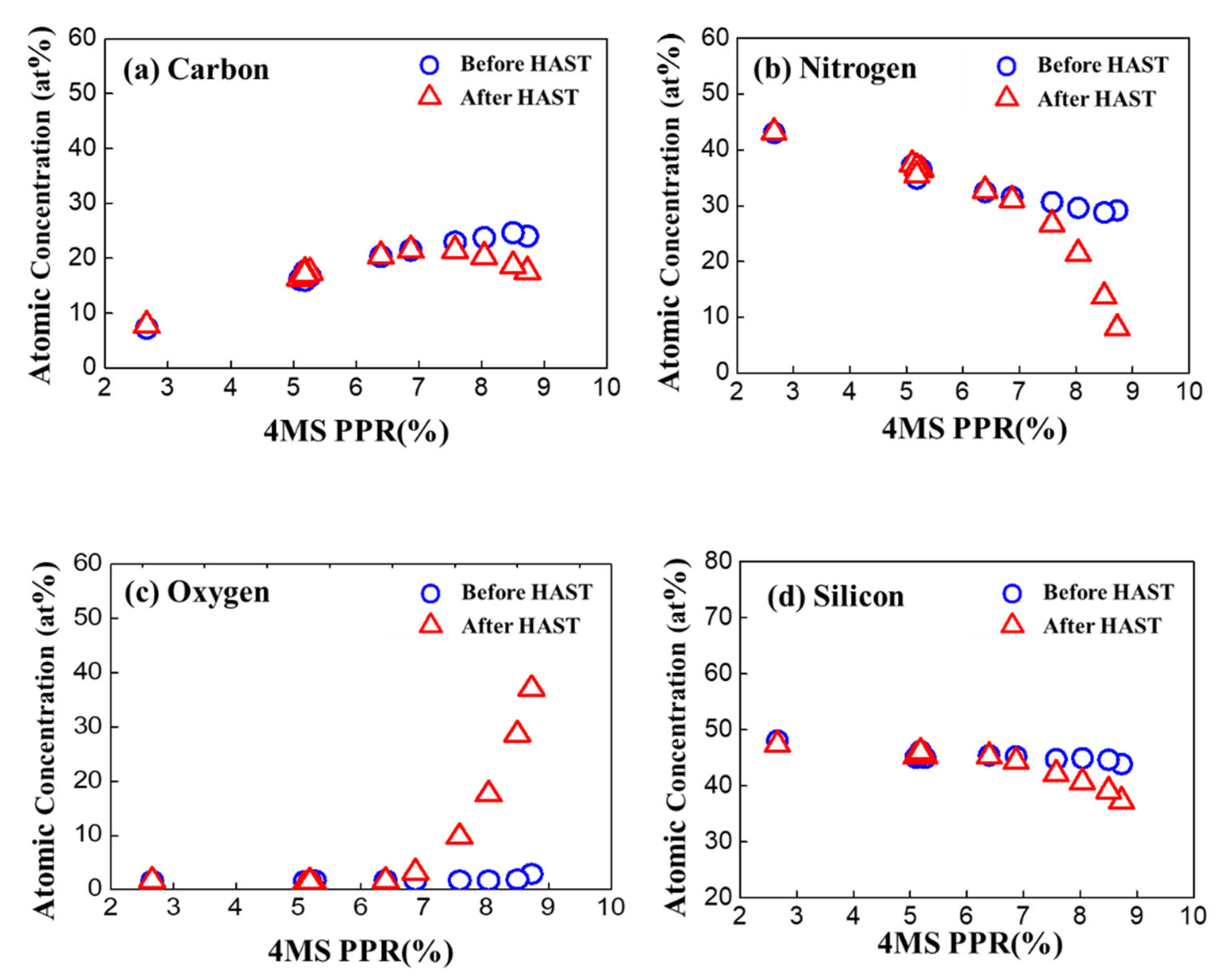
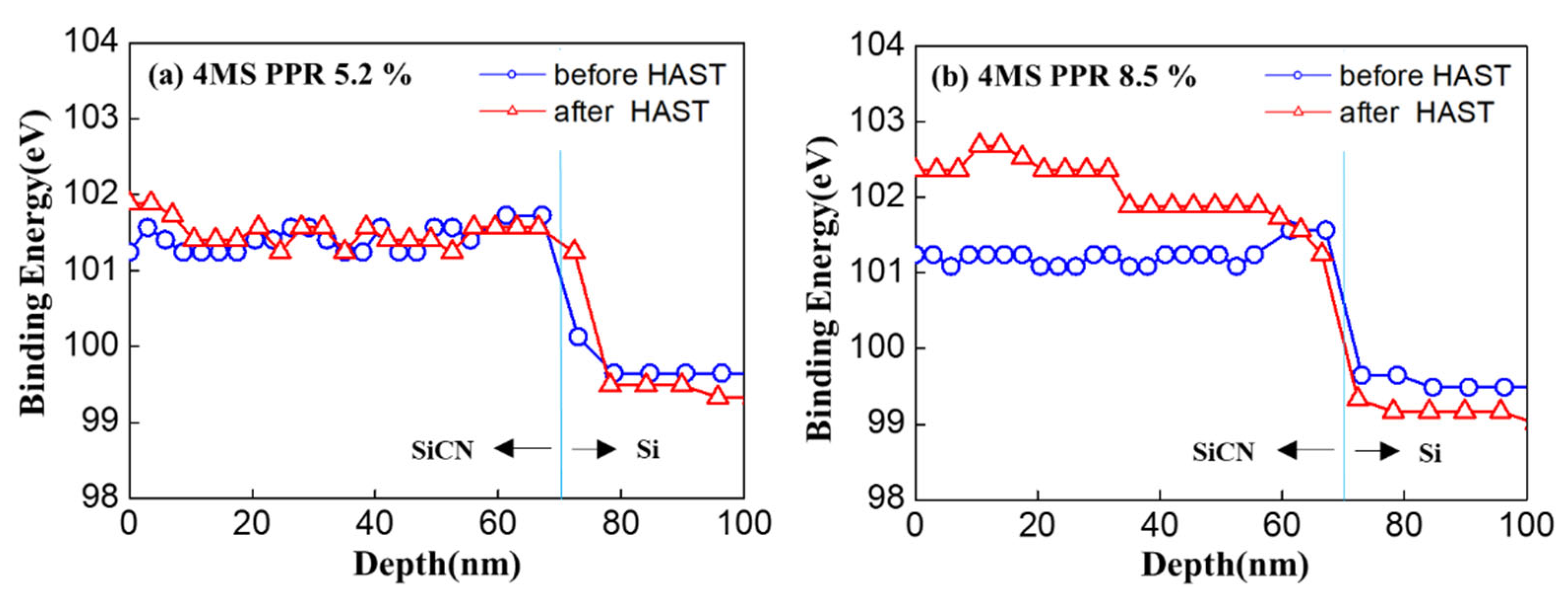
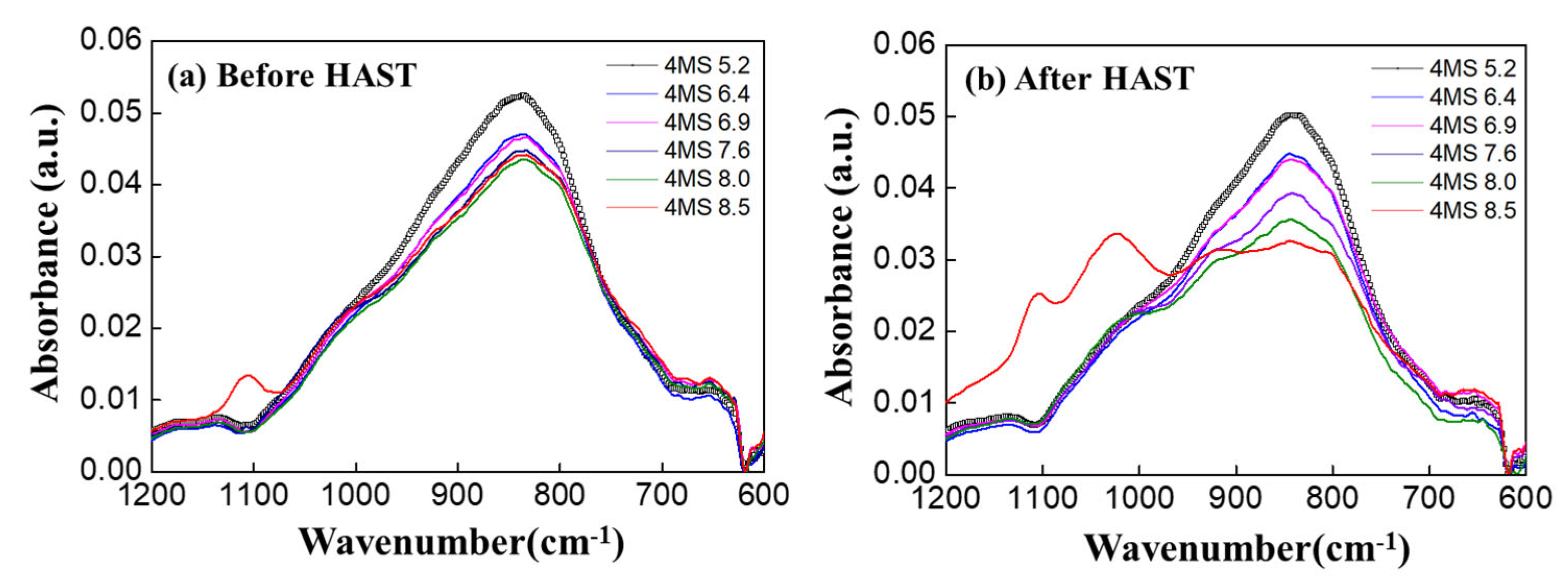
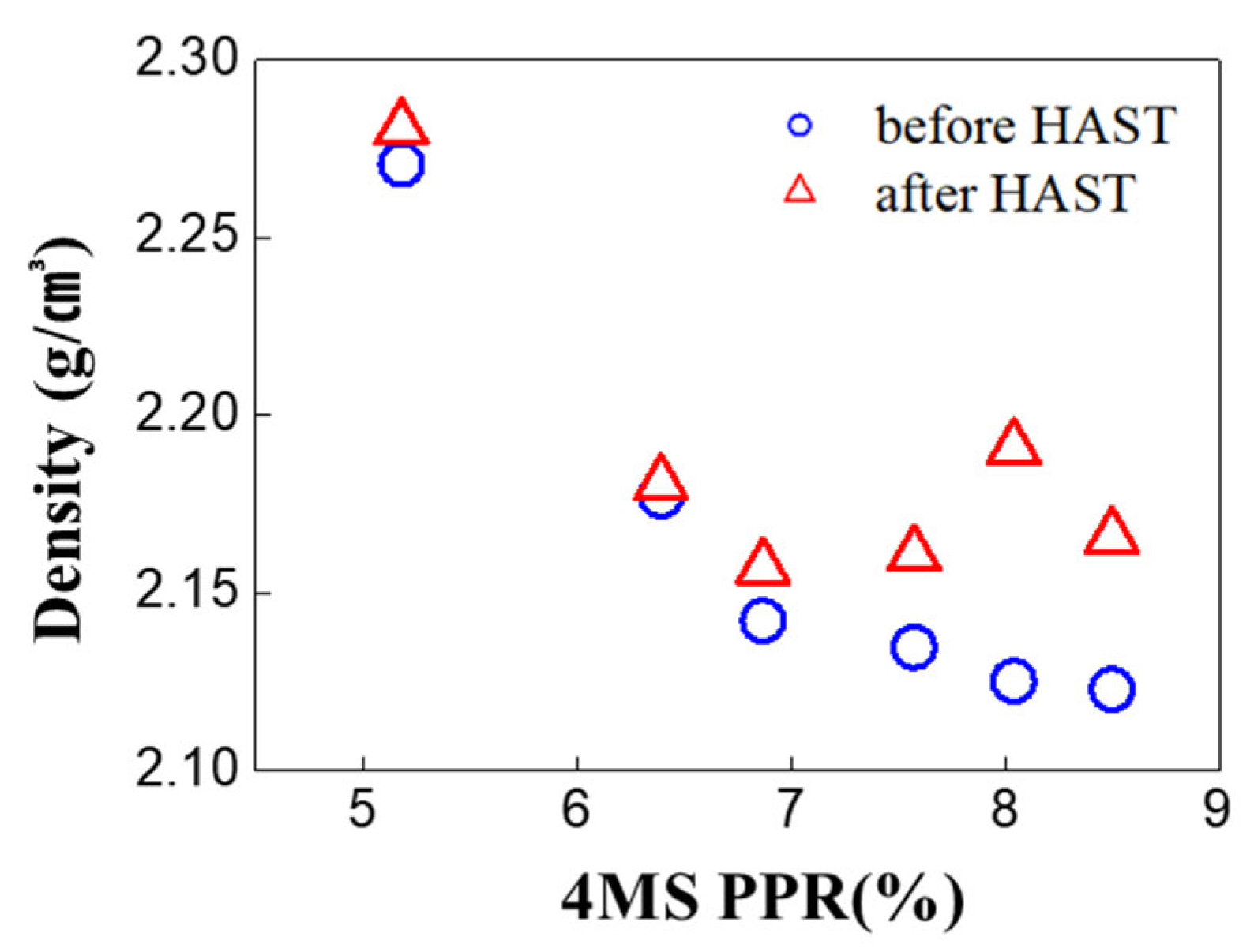
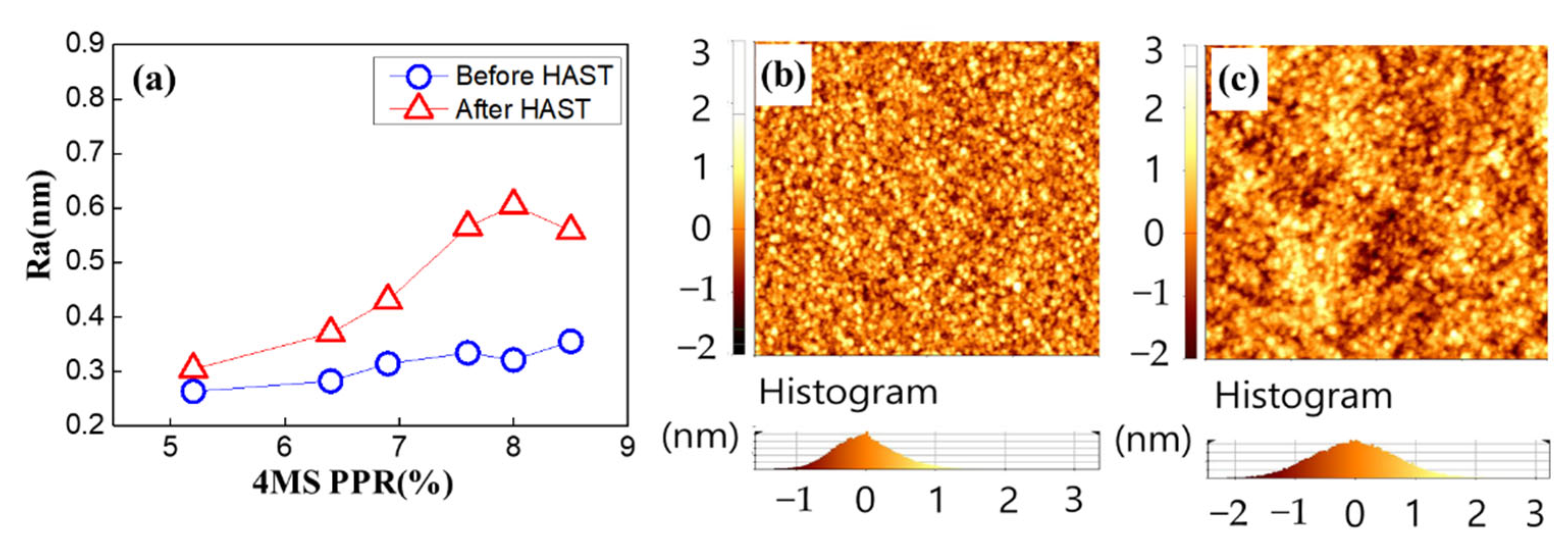
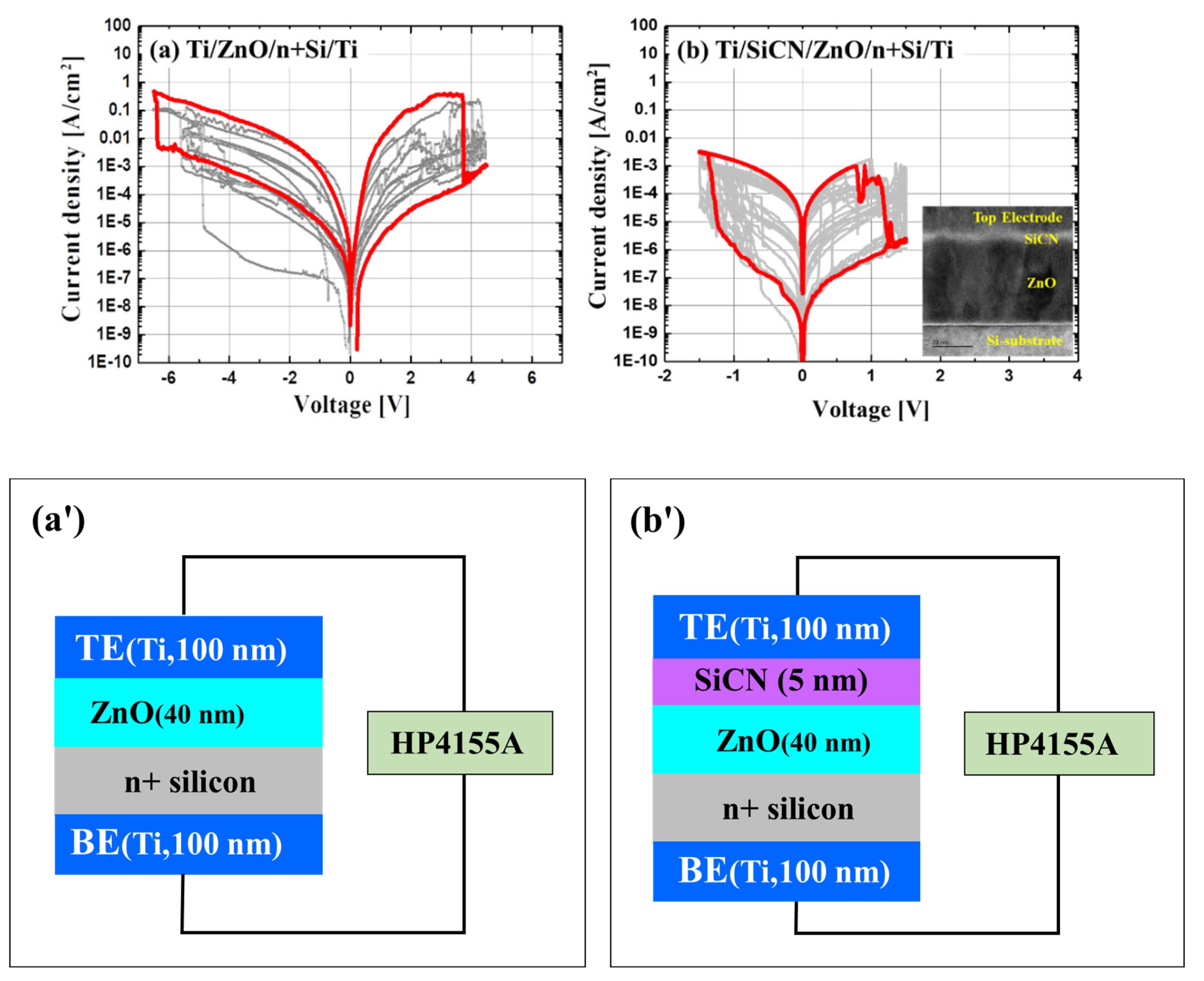
| 4MS PPR | Temp. | Pressure | Power | Gas Flow (sccm) | |||
|---|---|---|---|---|---|---|---|
| (°C) | (Torr) | (Watt) | 4MS | NH3 | He | N2 | |
| 5.2% | 350 | 4.2 | 650 | 200 | 1860 | 1550 | 250 |
| 6.4% | 350 | 4.2 | 650 | 250 | 1860 | 1550 | 250 |
| 6.9% | 350 | 4.2 | 650 | 270 | 1860 | 1550 | 250 |
| 7.6% | 350 | 4.2 | 650 | 300 | 1860 | 1550 | 250 |
| 8.0% | 350 | 4.2 | 650 | 320 | 1860 | 1550 | 250 |
| 8.5% | 350 | 4.2 | 650 | 340 | 1860 | 1550 | 250 |
| RRAM with | Set Voltage [V] | Reset Voltage [V] | On/Off Ratio | Endurance [Cycles] |
|---|---|---|---|---|
| ZnO Only | −5.26 | 3.37 | 127 | <10 |
| ZnO with SiCN | −1.3 | 1.125 | 69 | 53 |
Publisher’s Note: MDPI stays neutral with regard to jurisdictional claims in published maps and institutional affiliations. |
© 2022 by the authors. Licensee MDPI, Basel, Switzerland. This article is an open access article distributed under the terms and conditions of the Creative Commons Attribution (CC BY) license (https://creativecommons.org/licenses/by/4.0/).
Share and Cite
Song, M.-H.; Ko, W.-S.; Kim, G.-H.; Choi, D.-H.; Lee, G.-W. Studies on Oxygen Permeation Resistance of SiCN Thin Film and RRAM Applications. Nanomaterials 2022, 12, 4342. https://doi.org/10.3390/nano12234342
Song M-H, Ko W-S, Kim G-H, Choi D-H, Lee G-W. Studies on Oxygen Permeation Resistance of SiCN Thin Film and RRAM Applications. Nanomaterials. 2022; 12(23):4342. https://doi.org/10.3390/nano12234342
Chicago/Turabian StyleSong, Myeong-Ho, Woon-San Ko, Geun-Ho Kim, Dong-Hyeuk Choi, and Ga-Won Lee. 2022. "Studies on Oxygen Permeation Resistance of SiCN Thin Film and RRAM Applications" Nanomaterials 12, no. 23: 4342. https://doi.org/10.3390/nano12234342
APA StyleSong, M.-H., Ko, W.-S., Kim, G.-H., Choi, D.-H., & Lee, G.-W. (2022). Studies on Oxygen Permeation Resistance of SiCN Thin Film and RRAM Applications. Nanomaterials, 12(23), 4342. https://doi.org/10.3390/nano12234342







